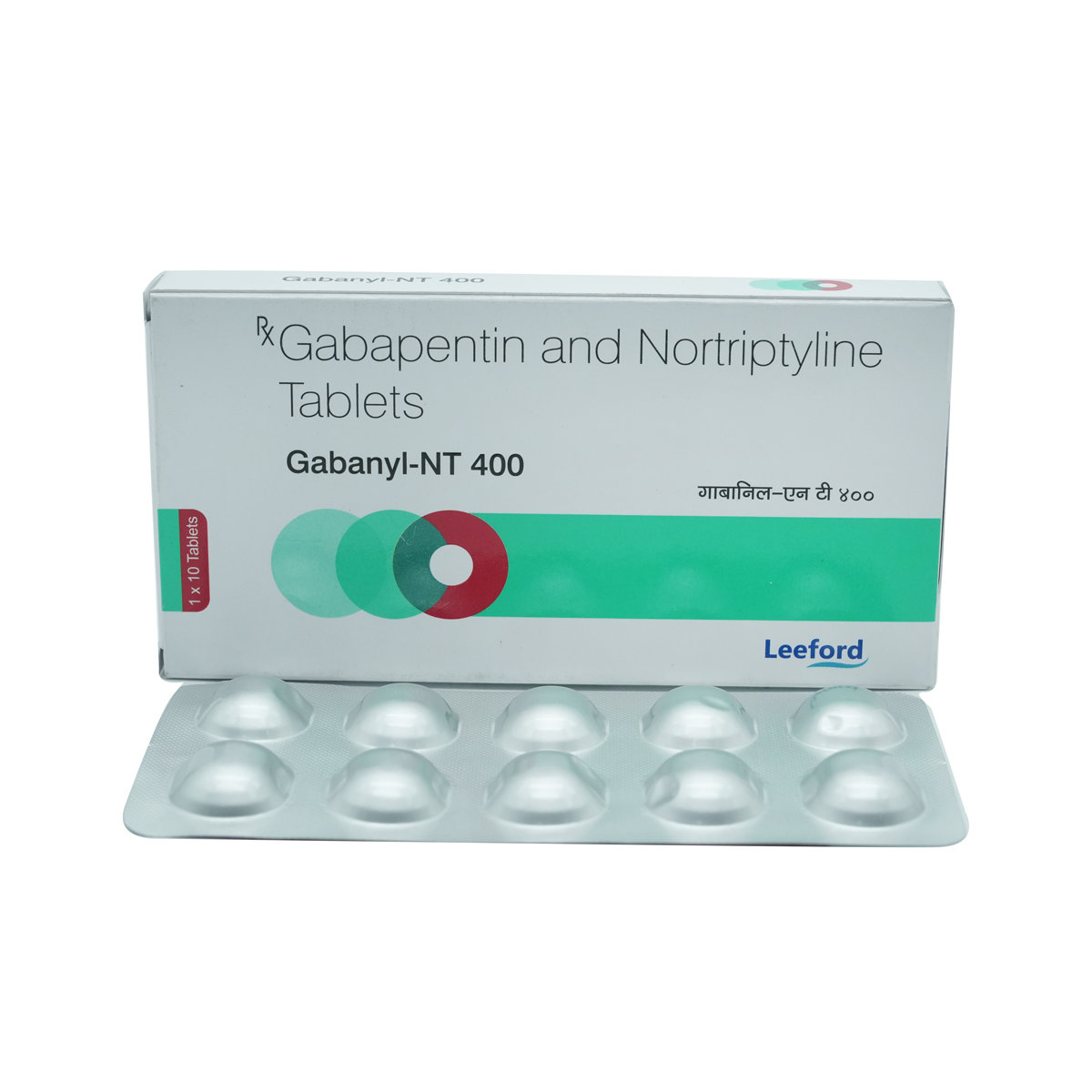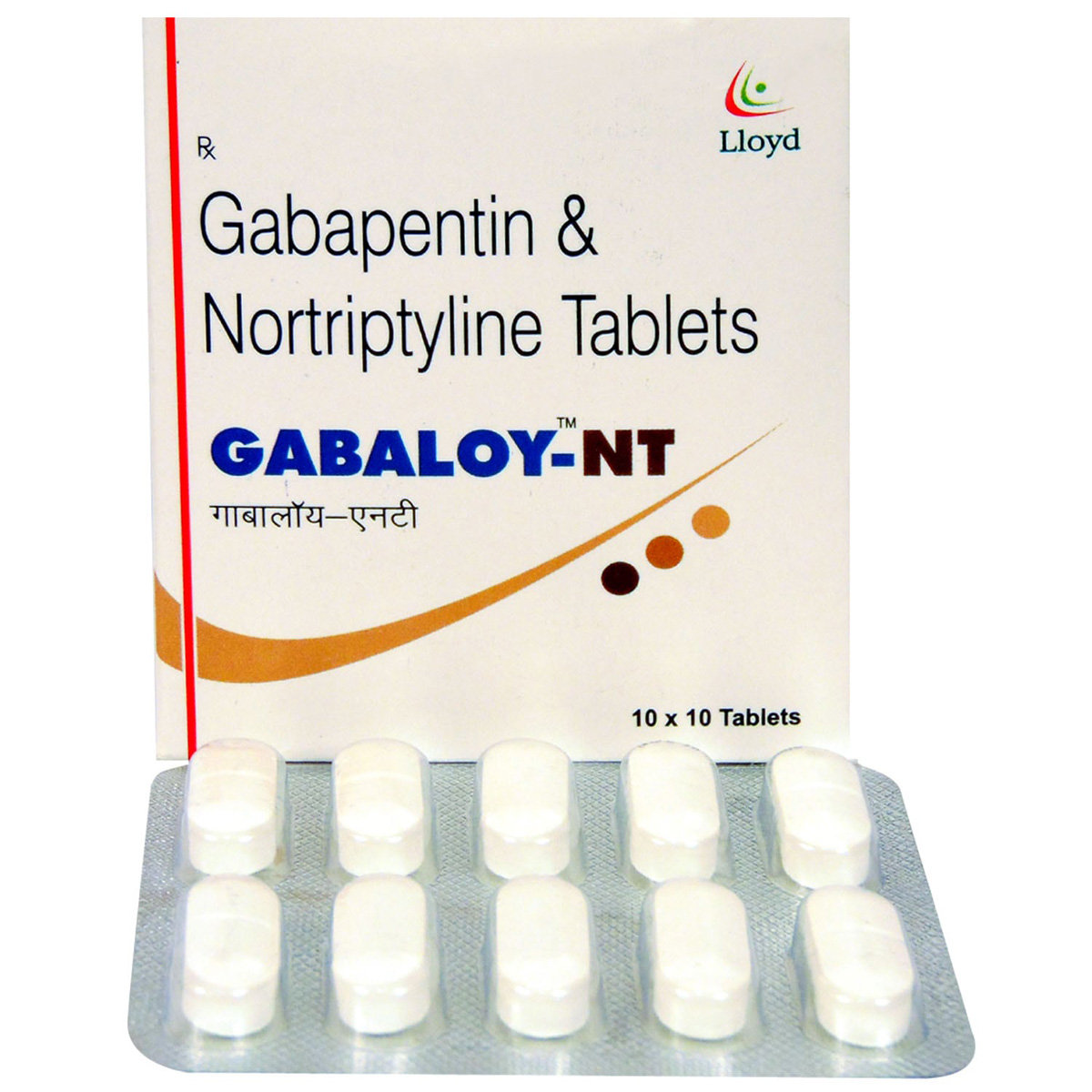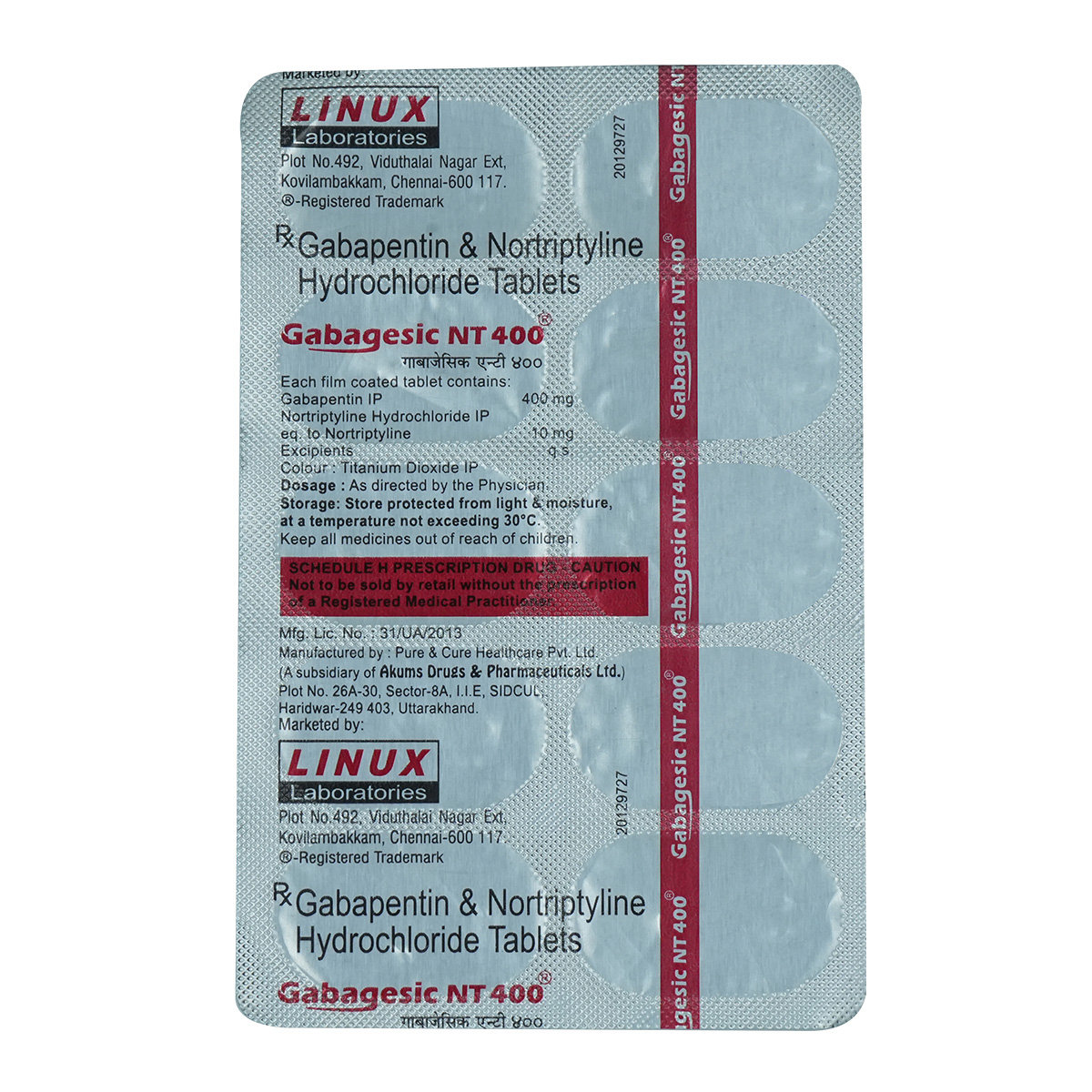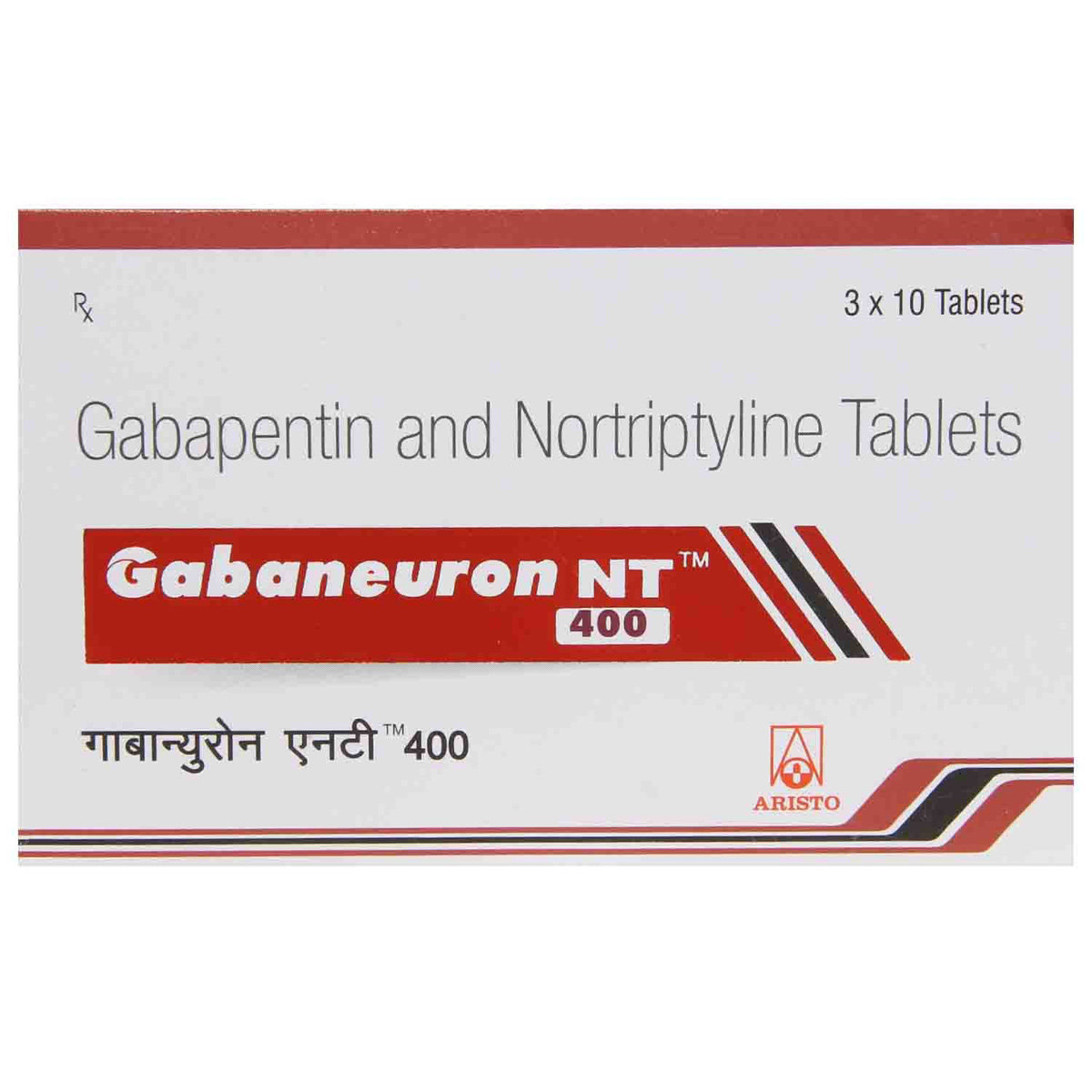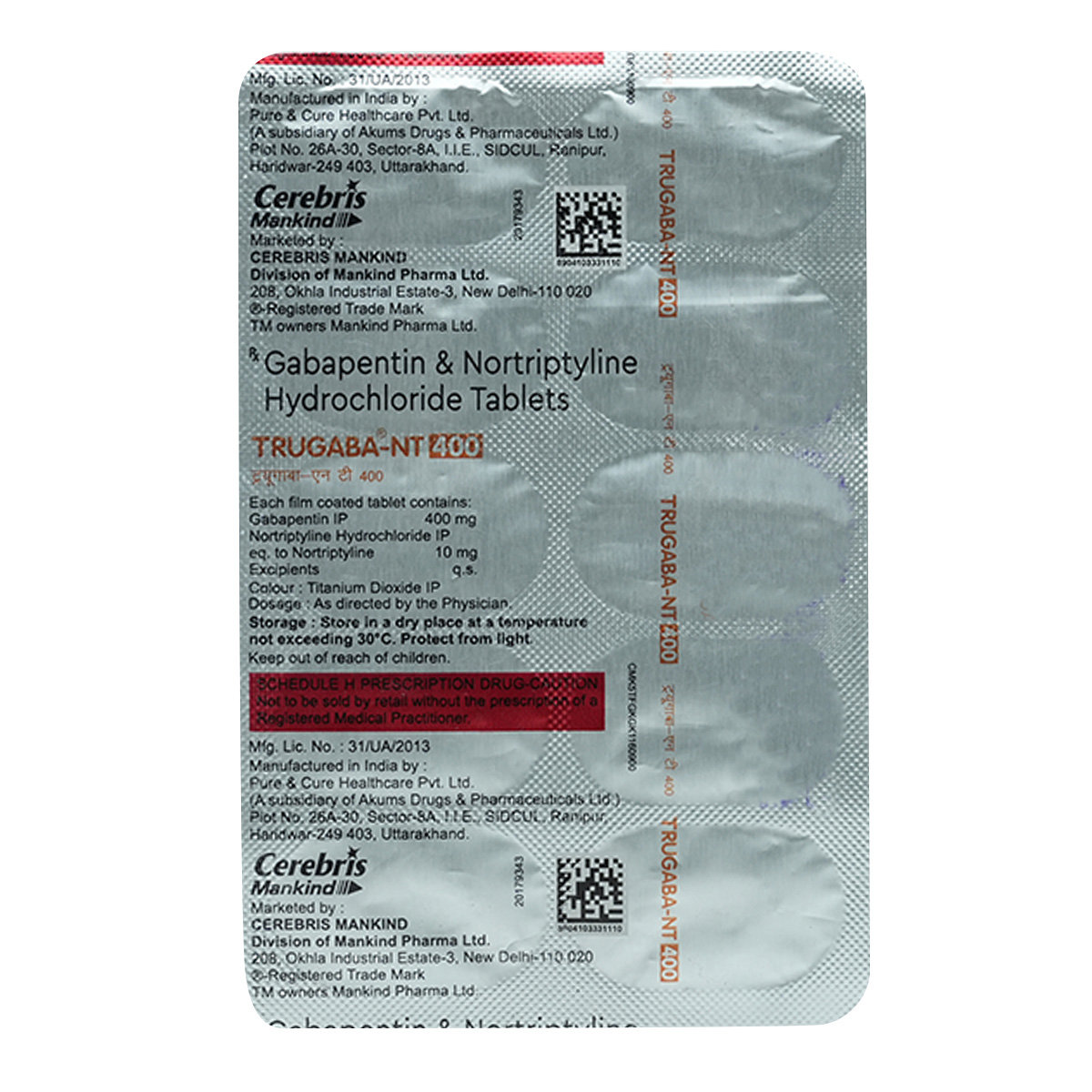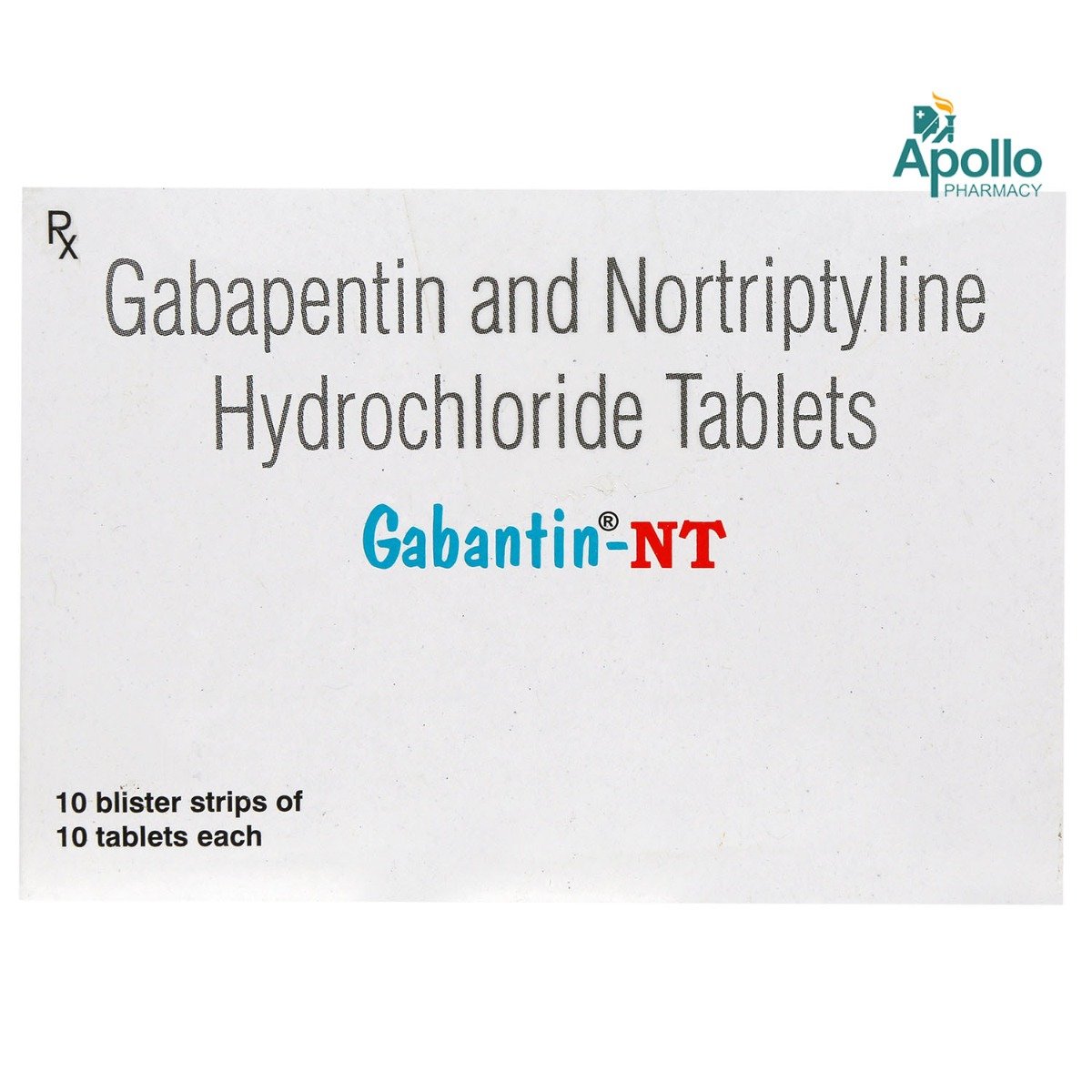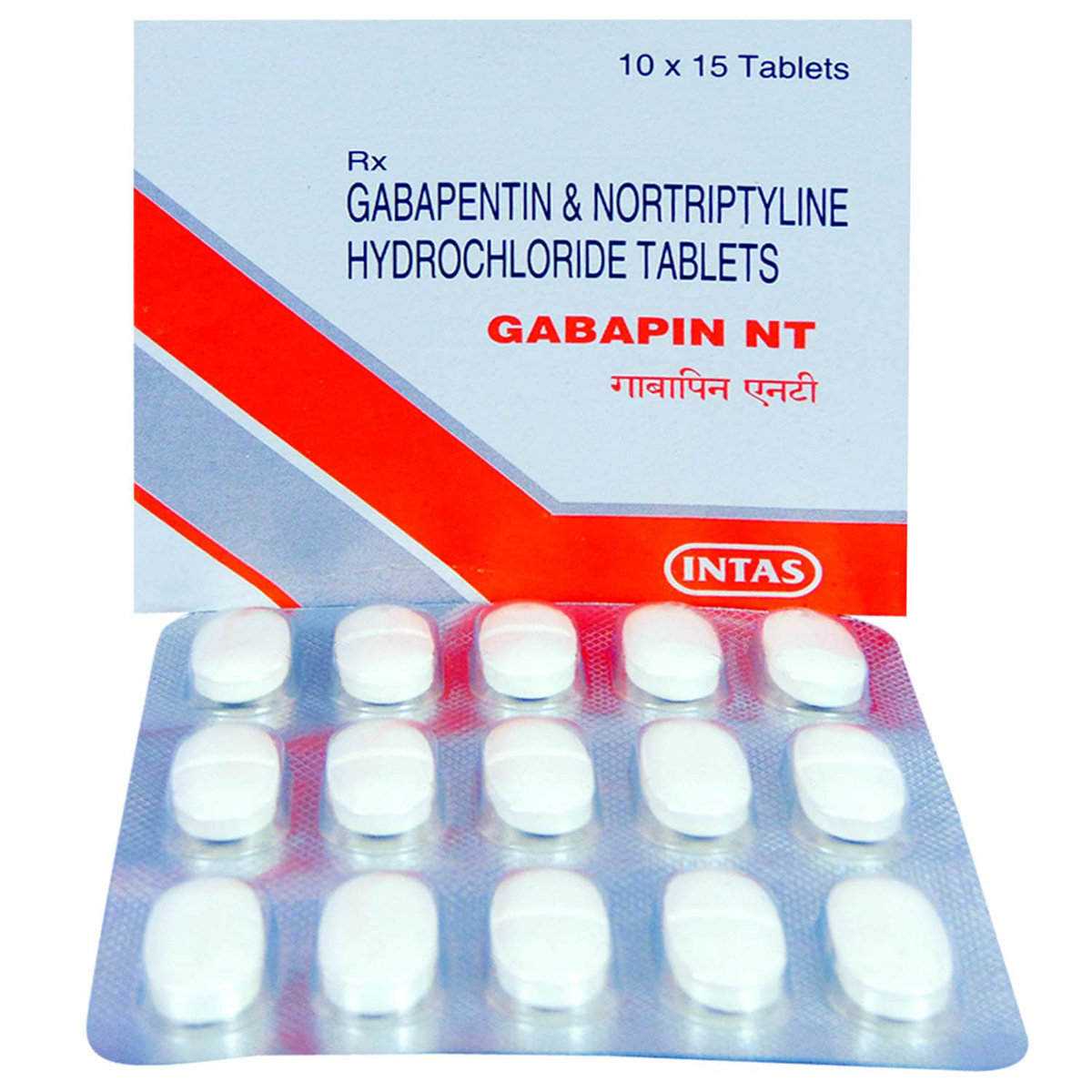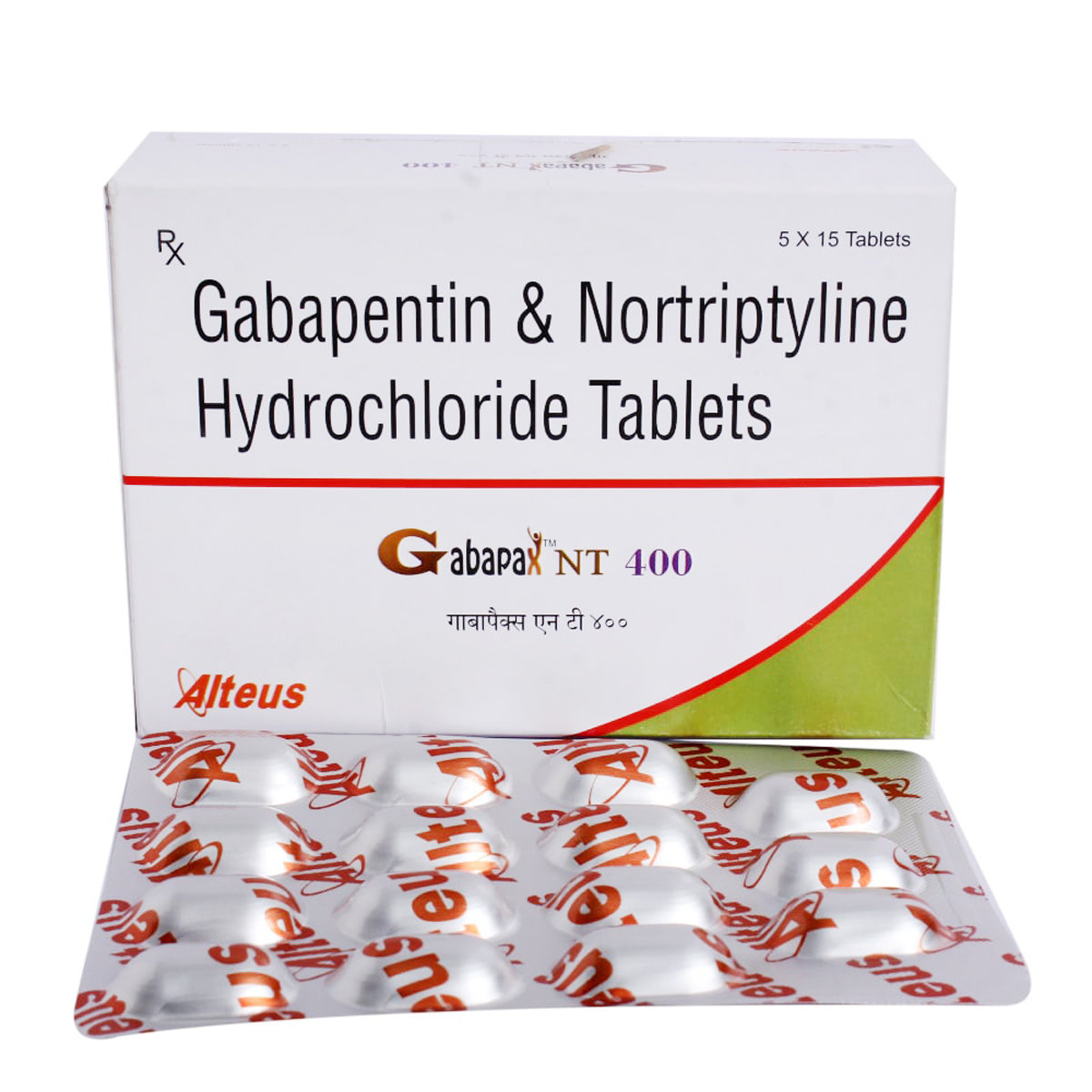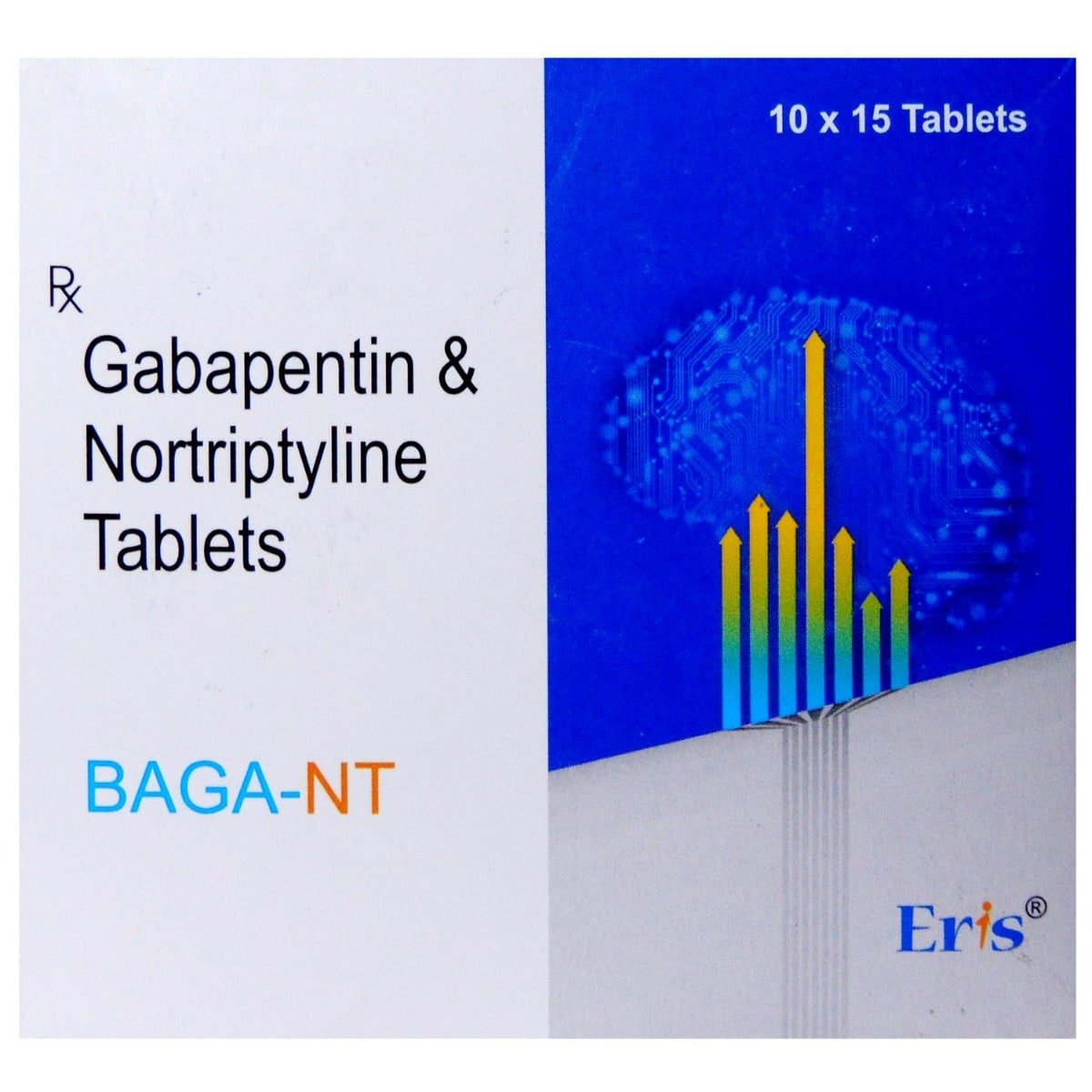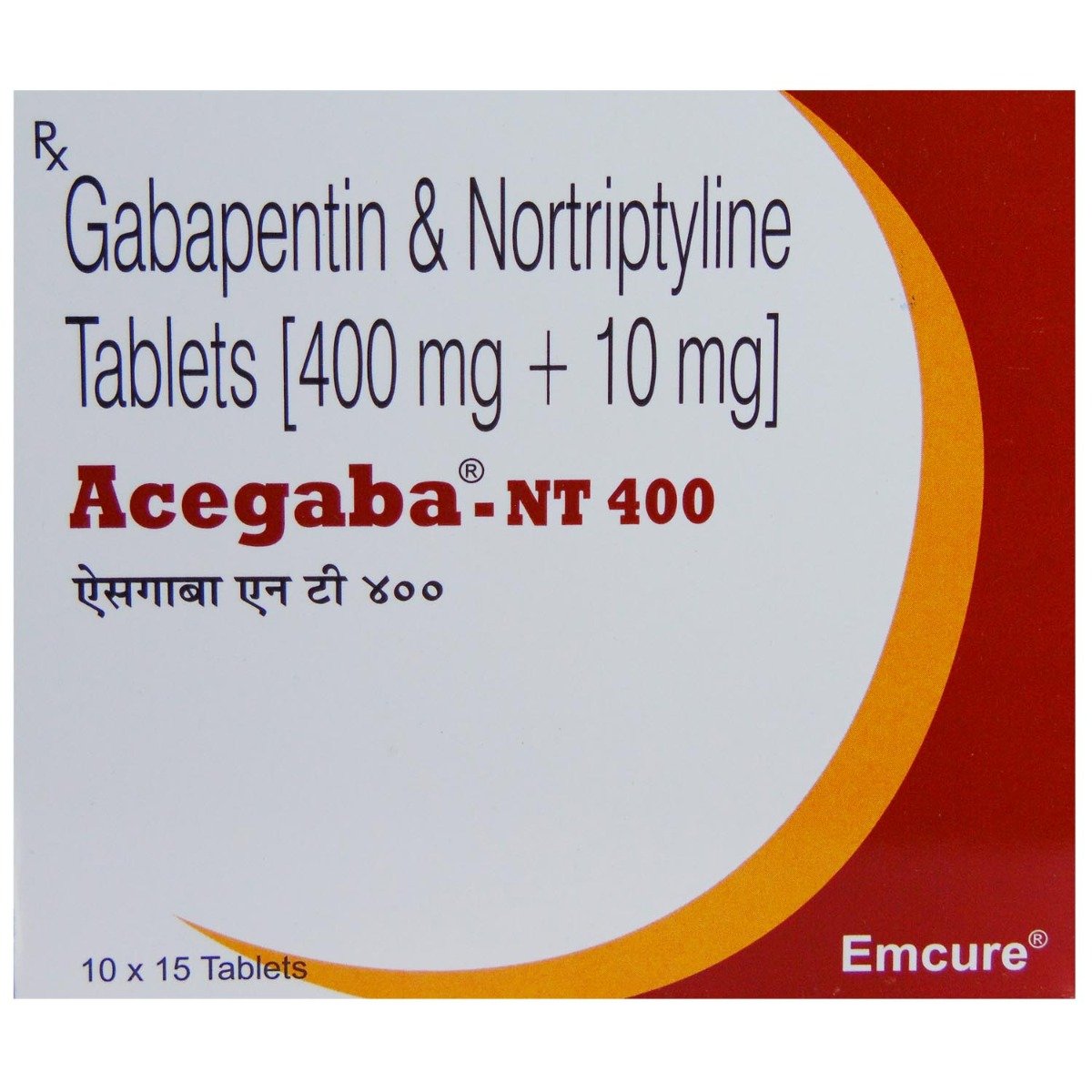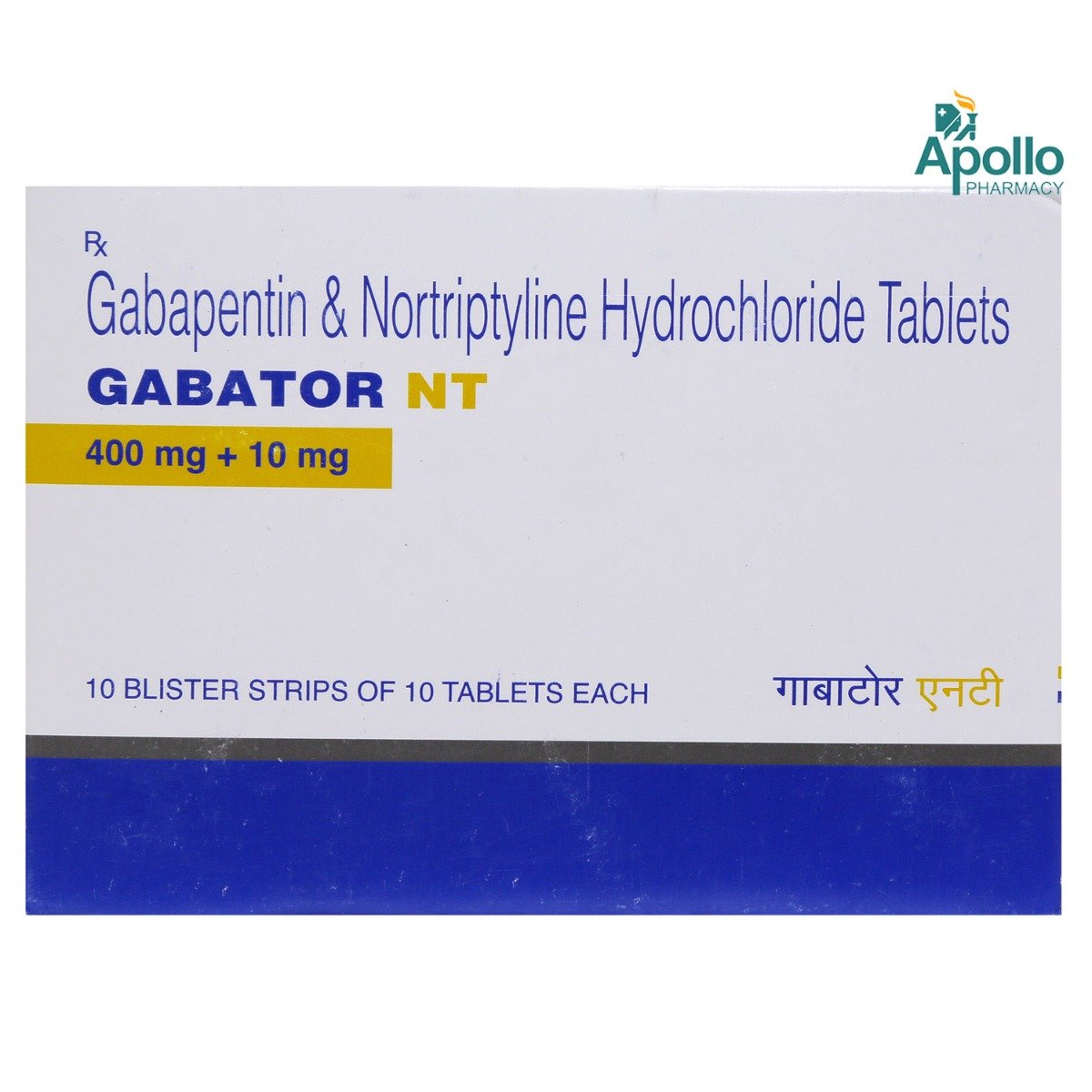Gabama-Nt Tablet

MRP ₹187
(Inclusive of all Taxes)
₹22.4 Cashback (12%)
know your delivery time
Provide Delivery Location
Composition :
Manufacturer/Marketer :
Consume Type :
Expires on or after :
Return Policy :

Secure Payment

Trusted by 8 Crore Indians

Genuine Products
Therapeutic Class
Country of origin
Manufacturer/Marketer address
Author Details
We provide you with authentic, trustworthy and relevant information
Disclaimer
Alcohol
Safe if prescribed
Avoid consumption of alcohol while taking Gabama-Nt Tablet as it may increase dizziness and sleepiness.
Pregnancy
Consult your doctor
Please consult your doctor if you have any concerns regarding this, your doctor will prescribe only if the benefits outweigh the risks.
Breast Feeding
Consult your doctor
Consult your doctor before taking Gabama-Nt Tablet ; your doctor will decide whether Gabama-Nt Tablet can be taken by breastfeeding mothers or not.
Driving
Safe if prescribed
Gabama-Nt Tablet may cause drowsiness, sleepiness and tiredness. Do not drive or operate machinery unless you are alert.
Liver
Consult your doctor
Dose adjustment may be needed in patients with liver impairment. Please consult your doctor if you have a liver impairment or any concerns regarding this.
Kidney
Consult your doctor
Dose adjustment may be needed in patients with kidney impairment. Please consult your doctor if you have kidney impairment or any concerns regarding this.
Children
Safe if prescribed
Gabama-Nt Tablet should not be given to children unless prescribed by the doctor.
Product Substitutes
About Gabama-Nt Tablet
Gabama-Nt Tablet is a combination medicine indicated for the management of neuropathic pain. It is a chronic progressive nerve disease that causes nerve pain. Symptoms include spontaneous, untriggered pain, unpleasant feeling, shooting, burning or stabbing pain, difficulty resting or sleeping, and evoked pain (pain caused by events that are usually not painful).
Gabama-Nt Tablet contains Gabapentin and Nortriptyline. Gabapentin works by binding to the specific site on voltage-gated calcium channels; this helps in relieving nerve pain. Nortriptyline prolongs the effect of serotonin and noradrenaline and prevents movements of pain signals in the brain.
In some cases, you may experience certain common side-effects such as dizziness, sleepiness, tiredness, headache, nausea, vomiting, blurred vision, dry mouth, and tingling sensations. Most of these side-effects do not require medical attention and will resolve gradually over time. However, you are advised to talk to your doctor if you experience these side-effects persistently.
Consult your doctor if you are pregnant or breastfeeding. Gabama-Nt Tablet may cause drowsiness and dizziness, so drive only if you are alert. Gabama-Nt Tablet should not be given to children unless prescribed by the doctor. Avoid consuming alcohol along with Gabama-Nt Tablet as it could lead to increased dizziness and sleepiness. Keep your doctor informed about your health condition and medicines to rule out any side-effects.
Uses of Gabama-Nt Tablet
Medicinal Benefits Mweb
Key Benefits
Gabama-Nt Tablet is used to treat neuropathic pain. Gabama-Nt Tablet is a combination of two drugs: Gabapentin and Nortriptyline. Gabapentin belongs to a class of drugs called anti-convulsants whereas Nortriptyline belongs to tricyclic antidepressants. Gabapentin works by binding to the specific site on voltage-gated calcium channels; this helps in relieving nerve pain and lowers the risk of seizures. On the other hand, Nortriptyline works by preventing the released chemical messenger in brains (serotonin and noradrenaline) from being reabsorbed back into the nerve cells (neuron) in the brain. As a result, it prolongs the effect of serotonin and noradrenaline in the brain and prevents the movement of pain signals in the brain.
Directions for Use
Side Effects of Gabama-Nt Tablet
- Dizziness
- Sleepiness
- Tiredness
- Headache
- Nausea
- Vomiting
- Blurred vision
- Dry mouth
Drug Warnings
Do not take Gabama-Nt Tablet if you are allergic to any of its contents. Inform your doctor before taking Gabama-Nt Tablet if you have/had heart problems or bipolar syndrome. Consult your doctor if you are pregnant or breastfeeding. Gabama-Nt Tablet may cause drowsiness and dizziness, so drive only if you are alert. Avoid consuming alcohol along with Gabama-Nt Tablet as it could lead to increased dizziness and sleepiness. Keep your doctor informed about your health condition and medicines to rule out any side-effects.
Drug-Drug Interactions
Drug-Drug Interactions
Login/Sign Up
Coadministration of Gabama-NT Tablet with Tranylcypromine can increase the risk of serotonin syndrome(a condition in which a chemical called serotonin increase in your body).
How to manage the interaction:
Taking Gabama-NT Tablet with Tranylcypromine together can result in an interaction, but can be taken together if prescribed by a doctor. However, consult a doctor if you experience confusion, hallucination(seeing and hearing things that do not exist), fits, blood pressure alteration, increased heart rate, fever, excessive sweating, shivering or shaking, blurred vision, pain in the muscles or stiffness, incoordination, stomach cramps, nausea, vomiting, and diarrhea. Do not discontinue any medications without consulting your doctor.
Coadministration of Gabama-NT Tablet with Potassium citrate can increase the risk or severity of gastric bleeding, ulceration, and rarely, perforation leading to serious blood loss.
How to manage the interaction:
Taking Gabama-NT Tablet with Potassium citrate together is not recommended as it can result in an interaction, it can be taken if your doctor has advised it. However, if you notice any unusual bleeding or bruising, dizziness, lightheadedness, abdominal pain, bloating, decreased hunger, red or black tarry stools, coughing up or vomiting blood, severe headache, and weakness, you should contact a doctor immediately. Do not stop using any medications without talking to a doctor.
Co-administration of Gabama-NT Tablet with Selegiline might raise serotonin hormone levels in the body (A condition in which a chemical called serotonin builds up in your body).
How to manage the interaction:
Taking Gabama-NT Tablet with Selegiline together can result in an interaction, it can be taken if a doctor has advised it. However, if you experience confusion, hallucination, fits, extreme changes in blood pressure, increased heart rate, fever, excessive sweating, shivering or shaking, blurred vision, muscle spasm or stiffness, tremors, incoordination, stomach cramps, nausea, vomiting, and diarrhea, contact a doctor immediately. Do not discontinue any medications without consulting a doctor.
Using Gabama-NT Tablet together with Isocarboxazid can increase the risk of serotonin syndrome (A condition resulting from the accumulation of high levels of serotonin in the body. Serotonin is especially a mood stabilizer).
How to manage the interaction:
Taking Isocarboxazid with Gabama-NT Tablet is not recommended, please consult your doctor before taking it. However, if you experience increased heart rate, fever, excessive sweating, shivering or shaking, blurred vision, muscle spasms or stiffness, tremors, incoordination, stomach cramps, nausea, vomiting, and diarrhea call a doctor. Do not discontinue any medications without consulting a doctor.
Coadministration of Gabama-NT Tablet with Ziprasidone can increase the risk or severity of irregular heart rhythm.
How to manage the interaction:
Taking Gabama-NT Tablet with Ziprasidone together can result in an interaction, it can be taken if your doctor has advised it. However, contact a doctor immediately if you experience sudden dizziness, lightheadedness, fainting, shortness of breath, chest pain or tightness, rapid heartbeat, severe or prolonged diarrhea, or vomiting. Do not discontinue any medications without consulting a doctor.
Coadministration of Gabama-NT Tablet with Linezolid might raise serotonin hormone levels in the body, affecting the brain and nerve cells. Increased serotonin hormone can lead to side effects.
How to manage the interaction:
Taking Gabama-NT Tablet with Linezolid together can result in an interaction, it can be taken if a doctor has advised it. However, if you experience confusion, hallucination, seizure, extreme changes in blood pressure, increased heart rate, fever, excessive sweating, shivering or shaking, blurred vision, muscle spasm or stiffness, tremors, incoordination, stomach cramps, nausea, vomiting, and diarrhea contact a doctor immediately. Do not discontinue any medications without consulting a doctor.
Coadministration of Gabama-NT Tablet with Safinamide may increase the risk of serotonin syndrome(a condition in which a chemical called serotonin increase in your body).
How to manage the interaction:
Taking Gabama-NT Tablet with Safinamide together can result in an interaction, but can be taken together if prescribed by a doctor. However, consult a doctor if you experience confusion, hallucination(seeing and hearing things that do not exist), fits, blood pressure alteration, increased heart rate, fever, excessive sweating, shivering or shaking, blurred vision, pain in the muscles or stiffness, incoordination, stomach cramps, nausea, vomiting, and loose stools. Do not discontinue any medications without consulting your doctor.
Coadministration of Gabama-NT Tablet with Ergotamine might raise serotonin hormone levels in the body, affecting the brain and nerve cells. Increased serotonin hormone can lead to side effects.
How to manage the interaction:
Taking Gabama-NT Tablet with Ergotamine together can result in an interaction, it can be taken if your doctor has advised it. However, if you experience confusion, hallucination, seizure, extreme changes in blood pressure, increased heart rate, fever, excessive sweating, shivering or shaking, blurred vision, muscle spasm or stiffness, tremors, incoordination, stomach cramps, nausea, vomiting, and diarrhea contact a doctor immediately. Do not discontinue any medications without consulting a doctor.
Gabama-NT Tablet can enhance the effects of Norepinephrine on blood pressure.
How to manage the interaction:
Although taking Norepinephrine and Gabama-NT Tablet together can cause an interaction, it can be taken if your doctor has suggested it. It's important to keep an eye on your blood pressure regularly. Do not stop using any medications without a doctor's advice.
Using Gabama-NT Tablet together with Frovatriptan can increase the risk of serotonin syndrome (A condition resulting from the accumulation of high levels of serotonin in the body. Serotonin is especially a mood stabilizer).
How to manage the interaction:
Although there is a possible interaction between Gabama-NT Tablet and Frovatriptan, you can take these medicines together if prescribed by your doctor. It's important to keep an eye on your health and be aware of any changes. If you notice any of these symptoms like confusion, shaking, or stomach cramps, it's a good idea to reach out to a doctor right away. They can help determine if there's anything serious going on and provide the necessary treatment. Do not stop using any medications without a doctor's advice.
Drug-Food Interactions
Drug-Food Interactions
Login/Sign Up
Drug-Diseases Interactions
Drug-Diseases Interactions
Login/Sign Up
Drug-Drug Interactions Checker List
- ZOLPIDEM
- CITALOPRAM
- DULOXETINE
- ESCITALOPRAM
- FLUOXETINE
- BUPROPION
- SERTRALINE
- CODEINE
- HYDROCODONE
- ACETAMINOPHEN
- OXYCODONE
- TRAMADOL
- DIPHENHYDRAMINE
- CETIRIZINE
- CYCLOBENZAPRINE
- CLONAZEPAM
- PREGABALIN
- TOPIRAMATE
- LEVOTHYROXINE SODIUM
- DIAZEPAM
- ALPRAZOLAM
- ONDANSETRON
- QUETIAPINE
- NALOXONE
- BUPRENORPHINE
- METHADONE
Habit Forming
Special Advise
- If you are taking any antacids containing aluminum or magnesium, try to keep at least 2 hours gap between intake of Gabama-Nt Tablet and these antacids to avoid drug-drug interaction.
- Gabama-Nt Tablet can make you feel dizzy or drowsy, try to get up slowly while rising from a sitting or lying position
Diet & Lifestyle Advise
- Include food rich in vitamins B and D in your diet.
- Include cayenne pepper in your diet, as it can help lower neuropathic pain.
- Exercising regularly helps in improving overall health and combating pain.
- Rest well, and get plenty of sleep.
- Try taking a warm bath, as it can be soothing.
- Avoid smoking and alcohol consumption.
- Meditation and yoga can help lower stress, decrease pain sensitivity and improves coping skills.
- Acupuncture can be helpful by stimulating pressure points.
- Using essential oils for massages can help increase circulation.
All Substitutes & Brand Comparisons
RX
Gabanyl-NT 400 Tablet 10's
Leeford Healthcare Ltd
₹178
(₹16.02 per unit)
2% CHEAPERRX
Transgaba-NT 400 mg Tablet 10's
Makeway Formulations Pvt Ltd
₹195
(₹17.55 per unit)
6% COSTLIERRX
Gabared NT Tablet 10's
Orris Pharmaceuticals
₹205
(₹18.45 per unit)
12% COSTLIER

Have a query?
Buy best C.n.s Drugs products by
Intas Pharmaceuticals Ltd
Sun Pharmaceutical Industries Ltd
Torrent Pharmaceuticals Ltd
Alkem Laboratories Ltd
Abbott India Ltd
Cipla Ltd
Alteus Biogenics Pvt Ltd
Micro Labs Ltd
Lupin Ltd
Ipca Laboratories Ltd
D D Pharmaceuticals Pvt Ltd
Icon Life Sciences
Mankind Pharma Pvt Ltd
Tripada Healthcare Pvt Ltd
Arinna Lifesciences Ltd
Linux Laboratories Pvt Ltd
East West Pharma India Pvt Ltd
La Renon Healthcare Pvt Ltd
Talent India Pvt Ltd
Tas Med India Pvt Ltd
Zydus Healthcare Ltd
Cnx Health Care Pvt Ltd
Eris Life Sciences Ltd
Leeford Healthcare Ltd
Emcure Pharmaceuticals Ltd
Macleods Pharmaceuticals Ltd
Sigmund Promedica
Aristo Pharmaceuticals Pvt Ltd
Dr Reddy's Laboratories Ltd
Troikaa Pharmaceuticals Ltd
Consern Pharma Ltd
Zydus Cadila
Shine Pharmaceuticals Ltd
Wockhardt Ltd
Ardent Life Sciences Pvt Ltd
Crescent Formulations Pvt Ltd
Theo Pharma Pvt Ltd
Reliance Formulation Pvt Ltd
Ikon Pharmaceuticals Pvt Ltd
Propel Healthcare
Neon Laboratories Ltd
Jagsam Pharma
Msn Laboratories Pvt Ltd
Morepen Laboratories Ltd
Pulse Pharmaceuticals
Sanofi India Ltd
Med Manor Organics Pvt Ltd
Hetero Healthcare Pvt Ltd
Novartis India Ltd
Crescent Therapeutics Ltd
Elder Pharmaceuticals Ltd
Solvate Laboratories Pvt Ltd
Akumentis Healthcare Ltd
Mova Pharmaceutical Pvt Ltd
Psyco Remedies Ltd
Tripada Lifecare Pvt Ltd
Ajanta Pharma Ltd
Cyrus Remedies Pvt Ltd
Medishri Healthcare Pvt Ltd
Cadila Healthcare Ltd
Glenmark Pharmaceuticals Ltd
Matteo Health Care Pvt Ltd
Hbc Life Sciences Pvt Ltd
Lyf Healthcare
Matias Healthcare Pvt Ltd
Mesmer Pharmaceuticals
Alembic Pharmaceuticals Ltd
Capital Pharma
Crescent Pharmaceuticals
Medopharm Pvt Ltd
Alniche Life Sciences Pvt Ltd
Kivi Labs Ltd
Talin Remedies Pvt Ltd
USV Pvt Ltd
Quince Lifesciences Pvt Ltd
Solis Pharmaceuticals
Infivis Life Care
Zuventus Healthcare Ltd
Cadila Pharmaceuticals Ltd
Pfizer Ltd
Wallace Pharmaceuticals Pvt Ltd
A N Pharmacia Laboratories Pvt Ltd
Blue Cross Laboratories Pvt Ltd
Jenburkt Pharmaceuticals Ltd
Lia Life Sciences Pvt Ltd
Mano Pharma
Medley Pharmaceuticals Ltd
Primus Remedies Pvt Ltd
FDC Ltd
Maneesh Pharmaceuticals Ltd
Apex Laboratories Pvt Ltd
Gagnant Healthcare Pvt Ltd
Ozone Pharmaceuticals Ltd
RPG Life Sciences Ltd
Strides Shasun Ltd
Unichem International
GlaxoSmithKline Pharmaceuticals Ltd
Kuresys Labs Pvt Ltd
LA Pharma
Trion Pharma India Llp

_0.jpg?tr=q-85)

